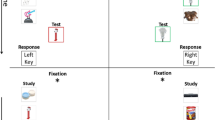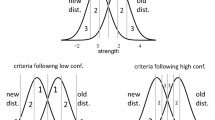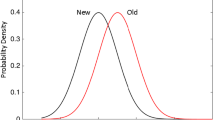Abstract
Models of recognition memory often assume that decisions are made independently from each other. Yet there is growing evidence that consecutive recognition responses show sequential dependencies, whereby making one response increases the probability of repeating that response from one trial to the next trial. Across six experiments, we replicated this response-related carryover effect using word and nonword stimuli and further demonstrated that the content of the previous trial—both perceptual and conceptual—can also bias the response to the current test probe, with both perceptual (orthographic) and conceptual (semantic) similarity boosting the probability of consecutive “old” responses. Finally, a manipulation of attentional engagement in Experiments 3a and 3b provided little evidence these carryover effects on recognition decisions are merely a product of lapses in attention. Taken together, the current study reinforces prior findings that recognition decisions are not made independently, and that multiple forms of information perseverate across consecutive trials.




Similar content being viewed by others
Data Availability
All data and materials are available online (https://osf.io/c2gsh/). It should be noted that a very similar statement is already present at the beginning of the Experiment 1a and 1b Methods section.
Notes
For each experiment, analyses were first conducted following a similar approach to that of Malmberg and Annis (2012). More specifically, we calculated the probability of hits and false alarms separately when the previous response was “old” and when it was “new.” This was done to ensure that the effects we observe are compatible with past findings, and to confirm that collapsing across response type (e.g., current trial hits and false alarms being aggregated into “old” responses) would not obscure meaningful patterns. In all cases, the patterns we observed were in line with those reported by Malmberg and Annis (2012). See Tables 1, 2, and 3 for hit and false-alarm rates following each response and content type in each experiment.
Reported beta-weights (b) reflect odds ratios (OR) converted from log(OR).
Research on prospective memory has posited that some forms of rare alternative responses (i.e., catch trials) can be responded to without imposing extra demands on attentional resources (Einstein & McDaniel, 2005). If the rare catch trial stimuli are able to spontaneously trigger the retrieval of the rules for the catch trials, then an overall increase in vigilance across the test would not be expected. However, consider that there are thirty unique catch trials for each participant, the identity of which are not known in advance. As a result, the catch trial rule is less concrete, theoretically making individual items less likely to spontaneously retrieve the secondary task rule, and thus require more active attentional control. To confirm that our catch trials increase task demands and therefore require heightened attention, we will compare RTs between these experiments and their catch-trial-free counterparts (Experiments 2a and 2b). Since a hallmark of spontaneous rule retrieval in the prospective memory literature is a lack of a difference in RTs between conditions that do and do not include the secondary task (Einstein & McDaniel, 2005), if we were to see slower reaction times at test in Experiments 3a and 3b relative to 2a and 2b, respectively, this would indicate that additional attention was required to perform the tasks successfully. We will additionally compare RT variability as a corroborating metric of attention.
References
Annis, J., & Malmberg, K. J. (2013). A model of positive sequential dependencies in judgments of frequency. Journal of Mathematical Psychology, 57(5), 225–236. https://doi.org/10.1016/j.jmp.2013.06.006
Bates, D., Mächler, M., Bolker, B., & Walker, S. (2015). Fitting linear mixed-effects models using lme4. Journal of Statistical Software, 67(1), 1–48. https://doi.org/10.18637/jss.v067.i01
Beaty, R. E., & Johnson, D. R. (2021). Automating creativity assessment with SemDis: An open platform for computing semantic distance. Behavior Research Methods, 53(2), 757–780. https://doi.org/10.3758/s13428-020-01453-w
Bruno, D., Higham, P. A., & Perfect, T. J. (2009). Global subjective memorability and the strength-based mirror effect in recognition memory. Memory & Cognition, 37(6), 807–818. https://doi.org/10.3758/MC.37.6.807
Brysbaert, M., Warriner, A. B., & Kuperman, V. (2014). Concreteness ratings for 40 thousand generally known English word lemmas. Behavior research methods, 46, 904–911. https://doi.org/10.3758/s13428-013-0403-5
Criss, A. H., Malmberg, K. J., & Shiffrin, R. M. (2011). Output interference in recognition memory. Journal of Memory and Language, 64(4), 316–326. https://doi.org/10.1016/j.jml.2011.02.003
Crump, M. J. C., & Logan, G. D. (2010). Episodic contributions to sequential control: Learning from a typist’s touch. Journal of Experimental Psychology: Human Perception and Performance, 36(3), 662–672. https://doi.org/10.1037/a0018390
Debettencourt, M. T., Keene, P. A., Awh, E., & Vogel, E. K. (2019). Real-time triggering reveals concurrent lapses of attention and working memory. Nature Human Behaviour, 3(8), 808–816.
Debettencourt, M. T., Norman, K. A., & Turk-Browne, N. B. (2018). Forgetting from lapses of sustained attention. Psychonomic Bulletin & Review, 25, 605–611.
Dollois, M. A., Poore-Buchhaupt, C. J., & Fiacconi, C. M. (2022). Another look at the contribution of motoric fluency to metacognitive monitoring. Canadian Journal of Experimental Psychology, 76(4), 251–269. https://doi.org/10.1037/cep0000278
Dosher, B. A., McElree, B., Hood, R. M., & Rosedale, G. (1989). Retrieval dynamics of priming in recognition memory: Bias and discrimination analysis. Journal of Experimental Psychology: Learning, Memory, and Cognition, 15(5), 868–886. https://doi.org/10.1037/0278-7393.15.5.868
Duke, D., Fiacconi, C. M., & Köhler, S. (2014). Parallel effects of processing fluency and positive affect on familiarity-based recognition decisions for faces. Frontiers in Psychology, 5, Article 328. https://doi.org/10.3389/fpsyg.2014.00328
Duncan, K., Sadanand, A., & Davachi, L. (2012). Memory’s penumbra: Episodic memory decisions induce lingering mnemonic biases. Science (American Association for the Advancement of Science), 337(6093), 485–487. https://doi.org/10.1126/science.1221936
Düzel, E., & Heinze, H. J. (2002). The effect of item sequence on brain activity during recognition memory. Brain Research. Cognitive Brain Research, 13(1), 115–127. https://doi.org/10.1016/S0926-6410(01)00102-1
Einstein, G. O., & McDaniel, M. A. (2005). Prospective memory: Multiple retrieval processes. Current Directions in Psychological Science, 14(6), 286–290. https://doi.org/10.1111/j.0963-7214.2005.00382.x
Fiacconi, C. M., Mitton, E. E., Laursen, S. J., & Skinner, J. (2020). Isolating the contribution of perceptual fluency to judgments of learning (JOLs): Evidence for reactivity in measuring the influence of fluency. Journal of Experimental Psychology: Learning, Memory, and Cognition, 46(5), 926–944. https://doi.org/10.1037/xlm0000766
Fischer, J., & Whitney, D. (2014). Serial dependence in visual perception. Nature Neuroscience, 17(5), 738–743. https://doi.org/10.1038/nn.3689
Green, D. M., & Swets, J. A. (1966). Signal detection theory and psychophysics (Vol. 1, pp. 1969–2012). Wiley.
Günther, F., Dudschig, C., & Kaup, B. (2015). LSAfun—An R package for computations based on latent semantic analysis. Behavior Research Methods, 47(4), 930–944. https://doi.org/10.3758/s13428-014-0529-0
Hautus, M. J. (1995). Corrections for extreme proportions and their biasing effects on estimated values of d′. Behavior Research Methods, Instruments, & Computers, 27, 46–51. https://doi.org/10.3758/BF03203619
Holland, M. K., & Lockhead, G. R. (1968). Sequential effects in absolute judgments of loudness. Perception & Psychophysics, 3(6), 409–414. https://doi.org/10.3758/BF03205747
Jacoby, L. L., & Dallas, M. (1981). On the relationship between autobiographical memory and perceptual learning. Journal of Experimental Psychology. General, 110(3), 306–340. https://doi.org/10.1037/0096-3445.110.3.306
Jacoby, L. L., & Whitehouse, K. (1989). An Illusion of Memory: False Recognition Influenced by Unconscious Perception. Journal of Experimental Psychology. General, 118(2), 126–135. https://doi.org/10.1037/0096-3445.118.2.126
Kantner, J., Solinger, L. A., Grybinas, D., & Dobbins, I. G. (2019). Confidence carryover during interleaved memory and perception judgments. Memory & Cognition, 47(2), 195–211. https://doi.org/10.3758/s13421-018-0859-8
Kurilla, B. P., & Westerman, D. L. (2008). Processing fluency affects subjective claims of recollection. Memory & Cognition, 36(1), 82–92. https://doi.org/10.3758/MC.36.1.82
Kuznetsova, A., Brockhoff, P. B., & Christensen, R. H. B. (2017). lmerTest package: Tests in linear mixed effects models. Journal of Statistical Software, 82(13), 1–26. https://doi.org/10.18637/jss.v082.i13
Lanska, M., Olds, J. M., & Westerman, D. L. (2014). Fluency effects in recognition memory: Are perceptual fluency and conceptual fluency interchangeable? Journal of Experimental Psychology: Learning, Memory, and Cognition, 40(1), 1–11. https://doi.org/10.1037/a0034309
Macmillan, N. A., & Creelman, C. D. (2005). Detection theory: A user’s guide. Psychology Press.
Malmberg, K. J., & Annis, J. (2012). On the relationship between memory and perception: Sequential dependencies in recognition memory testing. Journal of Experimental Psychology. General, 141(2), 233–259. https://doi.org/10.1037/a0025277
Masson, M. E. J. (1986). Identification of typographically transformed words: Instance-based skill acquisition. Journal of Experimental Psychology: Learning, Memory, and Cognition, 12(4), 479–488. https://doi.org/10.1037/0278-7393.12.4.479
Miller, J. K., Lloyd, M. E., & Westerman, D. L. (2008). When does modality matter? Perceptual versus conceptual fluency-based illusions in recognition memory. Journal of Memory and Language, 58(4), 1080–1094. https://doi.org/10.1016/j.jml.2007.12.006
Morey, R. D. (2008). Confidence intervals from normalized data: A correction to Cousineau (2005). Tutorials in Quantitative Methods for Psychology, 4(2), 61–64. https://doi.org/10.20982/tqmp.04.2.p061
Morrell, H. E. R., Gaitan, S., & Wixted, J. T. (2002). On the nature of the decision axis in signal-detection-based models of recognition memory. Journal of Experimental Psychology: Learning, Memory, and Cognition, 28(6), 1095–1110. https://doi.org/10.1037/0278-7393.28.6.1095
Notebaert, W., Houtman, F., Opstal, F. V., Gevers, W., Fias, W., & Verguts, T. (2009). Post-error slowing: An orienting account. Cognition, 111(2), 275–279. https://doi.org/10.1016/j.cognition.2009.02.002
Patil, A., & Duncan, K. (2018). Lingering cognitive states shape fundamental mnemonic abilities. Psychological Science, 29(1), 45–55. https://doi.org/10.1177/0956797617728592
R Core Team. (2022, November 1). R: A language and environment for statistical computing. R Foundation for Statistical Computing. https://www.rproject.org/
Rajaram, S. (1993). Remembering and knowing: Two means of access to the personal past. Memory & Cognition, 21, 89–102. https://doi.org/10.3758/BF03211168
Rajaram, S., & Geraci, L. (2000). Conceptual fluency selectively influences knowing. Journal of Experimental Psychology: Learning, Memory, and Cognition, 26(4), 1070–1074. https://doi.org/10.1037/0278-7393.26.4.1070
Rastle, K., Harrington, J., & Coltheart, M. (2002). 358,534 nonwords: The ARC nonword database. The Quarterly Journal of Experimental Psychology Section A, 55(4), 1339–1362. https://doi.org/10.1080/02724980244000099
Ratcliff, R., & Starns, J. J. (2009). Modeling confidence and response time in recognition memory. Psychological Review, 116(1), 59–83. https://doi.org/10.1037/a0014086
Robertson, I. H., Manly, T., Andrade, J., Baddeley, B. T., & Yiend, J. (1997). Oops!’: Performance correlates of everyday attentional failures in traumatic brain injured and normal subjects. Neuropsychologia, 35(6), 747–758.
Seli, P., Cheyne, J. A., & Smilek, D. (2013). Wandering minds and wavering rhythms: Linking mind wandering and behavioral variability. Journal of Experimental Psychology: Human Perception and Performance, 39(1), 1–5. https://doi.org/10.1037/a0030954
Shiffrin, R. M., & Steyvers, M. (1997). A model for recognition memory: REM—Retrieving effectively from memory. Psychonomic Bulletin & Review, 4(2), 145–166. https://doi.org/10.3758/BF03209391
Singer, M., & Wixted, J. T. (2006). Effect of delay on recognition decisions: Evidence for a criterion shift. Memory & Cognition, 34(1), 125–137. https://doi.org/10.3758/BF03193392
Stewart, N., & Brown, G. D. (2004). Sequence effects in the categorization of tones varying in frequency. Journal of Experimental Psychology: Learning, Memory, and Cognition, 30(2), 416–430. https://doi.org/10.1037/0278-7393.30.2.416
Stewart, N., Brown, G. D., & Chater, N. (2002). Sequence effects in categorization of simple perceptual stimuli. Journal of Experimental Psychology: Learning, Memory, and Cognition, 28(1), 3–11. https://doi.org/10.1037/0278-7393.28.1.3
Stretch, V., & Wixted, J. T. (1998). On the difference between strength-based and frequency-based mirror effects in recognition memory. Journal of Experimental Psychology: Learning, Memory, and Cognition, 24(6), 1379–1396. https://doi.org/10.1037/0278-7393.24.6.1379
Susser, J. A., Jin, A., & Mulligan, N. W. (2016). Identity priming consistently affects perceptual fluency but only affects metamemory when primes are obvious. Journal of Experimental Psychology: Learning, Memory, and Cognition, 42(4), 657–662. https://doi.org/10.1037/xlm0000189
Taylor, J. R., & Henson, R. N. (2012). Could masked conceptual primes increase recollection? The subtleties of measuring recollection and familiarity in recognition memory. Neuropsychologia, 50(13), 3027–3040. https://doi.org/10.1016/j.neuropsychologia.2012.07.029
Treisman, M., & Williams, T. C. (1984). A theory of criterion setting with an application to sequential dependencies. Psychological Review, 91(1), 68–111. https://doi.org/10.1037/0033-295X.91.1.68
Verde, M. F., & Rotello, C. M. (2007). Memory strength and the decision process in recognition memory. Memory & Cognition, 35(2), 254–262. https://doi.org/10.3758/BF03193446
Ward, L. M., & Lockhead, G. R. (1971). Response system processes in absolute judgment. Perception & Psychophysics, 9(1), 73–78. https://doi.org/10.3758/BF03213031
Westerman, D. L. (2008). Relative fluency and illusions of recognition memory. Psychonomic Bulletin & Review, 15(6), 1196–1200. https://doi.org/10.3758/PBR.15.6.1196
Whittlesea, B. W. A. (1993). Illusions of Familiarity. Journal of Experimental Psychology. Learning, Memory, and Cognition, 19(6), 1235–1253. https://doi.org/10.1037/0278-7393.19.6.1235
Whittlesea, B. W. A. (2002). False Memory and the Discrepancy-Attribution Hypothesis: The Prototype-Familiarity Illusion. Journal of Experimental Psychology. General, 131(1), 96–115. https://doi.org/10.1037/0096-3445.131.1.96
Whittlesea, B. W., Jacoby, L. L., & Girard, K. (1990). Illusions of immediate memory: Evidence of an attributional basis for feelings of familiarity and perceptual quality. Journal of Memory and Language, 29(6), 716–732. https://doi.org/10.1016/0749-596X(90)90045-2
Whittlesea, B. W. A., & Williams, L. D. (2001). The discrepancy-attribution hypothesis: I. The heuristic basis of feelings of familiarity. Journal of Experimental Psychology: Learning, Memory, and Cognition, 27(1), 3–13. https://doi.org/10.1037/0278-7393.27.1.3
Acknowledgments
The authors would like to thank Robyn T. Mahood for their contributions to this project.
Funding
Natural Sciences and Engineering Research Council of Canada,06032.
Author information
Authors and Affiliations
Corresponding author
Additional information
Publisher's Note
Springer Nature remains neutral with regard to jurisdictional claims in published maps and institutional affiliations.
Rights and permissions
Springer Nature or its licensor (e.g. a society or other partner) holds exclusive rights to this article under a publishing agreement with the author(s) or other rightsholder(s); author self-archiving of the accepted manuscript version of this article is solely governed by the terms of such publishing agreement and applicable law.
About this article
Cite this article
Dollois, M.A., Fenske, M.J. & Fiacconi, C.M. Information perseveration in recognition memory: Examining the scope of sequential dependencies. Mem Cogn (2024). https://doi.org/10.3758/s13421-024-01582-z
Accepted:
Published:
DOI: https://doi.org/10.3758/s13421-024-01582-z




